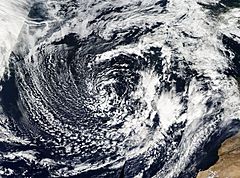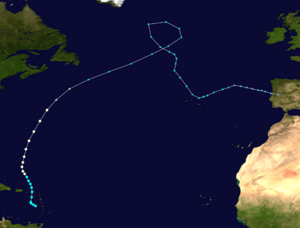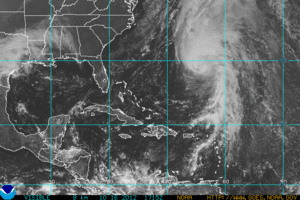Hurricane Rafael facts for kids
| Category 1 hurricane (SSHWS/NWS) | |

Hurricane Rafael near peak intensity on October 16
|
|
| Formed | October 12, 2012 |
|---|---|
| Dissipated | October 26, 2012 |
| (Extratropical after October 17) | |
| Highest winds | 1-minute sustained: 90 mph (150 km/h) |
| Lowest pressure | 969 mbar (hPa); 28.61 inHg (966 mbar (28.53 inHg) while extratropical) |
| Fatalities | 1 total |
| Damage | ≤ $2 million (2012 USD) |
| Areas affected | Lesser Antilles, Puerto Rico, Bermuda, Atlantic Canada, United States East Coast, Azores, Western Europe |
| Part of the 2012 Atlantic hurricane season | |
Hurricane Rafael was a storm that caused some damage in the northeastern Caribbean Sea in October 2012. It was the seventeenth named storm and the ninth hurricane of the 2012 Atlantic hurricane season. Rafael started as a tropical wave on October 12, 2012, near Saint Croix. It quickly became a tropical storm because it already had strong winds.
Even though it started a bit messy, Rafael grew stronger. By October 15, it became a Category 1 hurricane. The storm then turned northeast and reached its strongest point on October 16, with winds of 90 mph (150 km/h). After that, Rafael moved into colder areas and changed into a different type of storm called an extratropical cyclone. This happened on October 17. The leftover storm kept going for nine more days, even reaching Portugal on October 26 before it finally disappeared.
When Rafael was a tropical storm in the Caribbean, it brought a lot of rain. Some places in the Lesser Antilles got as much as a foot of rain! This caused mudslides, landslides, and rivers to overflow. The heavy rain also damaged many crops. Strong winds were felt in places like Saint Martin, and lightning caused fires and power outages. Sadly, one person was swept away in Guadeloupe when they tried to drive through a flooded road. When Rafael passed Bermuda as a hurricane, it caused some rain and winds over 50 mph (85 km/h), leaving hundreds of homes without power. Later, big waves from the storm damaged the coast of Nova Scotia in Canada, washing away roads. Overall, the damage from Hurricane Rafael was not too severe.
Contents
How Hurricane Rafael Formed and Grew
Hurricane Rafael began as a tropical wave that moved off the coast of Africa on October 5. A tropical wave is like a ripple in the atmosphere that can sometimes grow into a storm. As this wave moved across the Atlantic Ocean, a low-pressure area started to form, and thunderstorms began to gather around it.
The National Hurricane Center (NHC) started watching this disturbance. They thought it had a good chance of becoming a tropical storm. As it got closer to the Leeward Islands, the low-pressure area became more organized. On October 12, the storm was strong enough to be named Tropical Storm Rafael. It was located about 200 mi (320 km) south-southeast of Saint Croix.
At first, Rafael was a bit messy because of strong wind shear. Wind shear is when winds blow in different directions at different heights, which can tear a storm apart. But over the next few days, the wind shear lessened. This allowed the storm to become more organized, and a clear center started to form. As Rafael began to turn north, it got even stronger. On October 15, it was upgraded to a hurricane. This was confirmed by special planes called hurricane hunters that fly into storms to measure their strength.

As Rafael moved north, it continued to get stronger quickly. On October 16, a clear eye could be seen on radar. This is when Rafael reached its strongest point as a Category 1 hurricane. Its winds reached 90 mph (150 km/h).
Later that day, the storm started to weaken. It moved over colder ocean waters and faced more wind shear. On October 17, Rafael began to change into an extratropical cyclone. This means it lost its tropical features and became more like a regular weather system, similar to a winter storm. This change was complete by the afternoon of October 17, when Rafael was southwest of Nova Scotia.
Even after becoming extratropical, Rafael's leftover storm kept moving. It traveled northeast across the Atlantic Ocean. From October 19 to 20, it even looped around a larger weather system near Greenland. During this time, the extratropical storm actually got stronger for a bit. After that, it continued moving east, heading towards Portugal. Rafael's remnant finally made landfall in Portugal on October 26 and then disappeared later that day.
Preparing for the Storm and Its Effects
Caribbean Islands
When Rafael first formed, people in the Caribbean islands started getting ready. A tropical storm watch was put in place for Puerto Rico. Warnings were also issued for nearby islands like the British and U.S. Virgin Islands. As the storm moved away, these warnings were gradually lifted.
To prepare, emergency centers were opened in the Virgin Islands. The Federal Emergency Management Agency (FEMA) sent a team to help. Public works and power companies got their crews ready. Ports were only open for ships leaving the U.S. Virgin Islands, and the Coast Guard told sailors to prepare for bad weather.
Rafael brought a lot of rain to Guadeloupe. In some areas, up to 12 in (300 mm) of rain fell in just 48 hours. This caused major damage to homes and especially to crops. About 60% to 80% of vegetable crops in Grande-Terre were damaged by floods and mudslides. Lightning from the strong storms also caused fires and power outages. Sadly, a person died in Matouba after trying to drive through a flooded road and being swept away.
In Saint Kitts, nearly 12 in (300 mm) of rain fell in 30 hours. This led to serious flooding and mudslides, especially around Basseterre. Roads became impossible to use, and most businesses closed. Many homes lost power and water. In the French islands of Saint Barthélemy and Saint Martin, wind gusts reached up to 67 mph (108 km/h). While some boats were stranded, the overall damage in these French areas was not too bad. In Puerto Rico, roads and some houses were flooded.
Bermuda
As Rafael moved out of the Caribbean, a tropical storm watch was issued for Bermuda on October 14. This was later upgraded to a tropical storm warning. People in Bermuda were told to take their usual storm precautions. Airlines also canceled many flights on October 16.
Officials warned about minor storm surge along the coast and expected 2 to 4 inches of rain. The winds were stronger than many locals expected, with gusts reaching 51 mph (82 km/h) at the airport. These winds caused about 600 homes to lose electricity. However, the rainfall was less than feared, only reaching about 1.71 in (43 mm).
Newfoundland, Canada
Even though no official warnings were issued for Newfoundland, Canada, city officials in St. John's told residents to get ready for Rafael. The leftover storm brought large waves and storm surge that caused a lot of damage along the Avalon Peninsula. Locals said the waves were even bigger than those from Hurricane Igor in 2010, which had caused a lot of damage.
Large parts of roads were washed away or covered in debris from the waves. Near Trepassey, a breakwater (a wall built to protect the coast) was destroyed in three places. This allowed waves to rush inland, creating a large gap in one of the main roads. About 50 people in an area called the Lower Coast were cut off from the rest of the area. The total damage in Newfoundland was estimated to be around C$1–2 million. The amount of rain from the storm was very light, only about 6 mm (0.24 in) in Cape Race.
Images for kids
See also
 In Spanish: Huracán Rafael para niños
In Spanish: Huracán Rafael para niños




